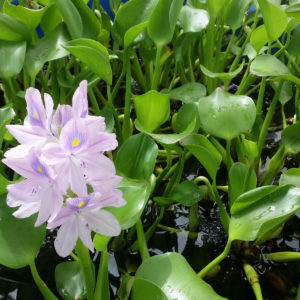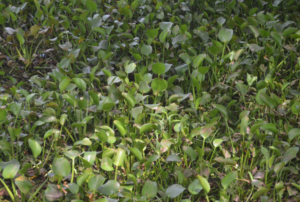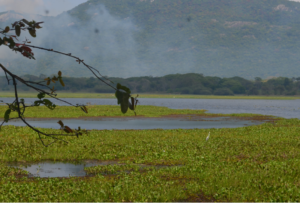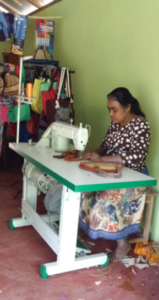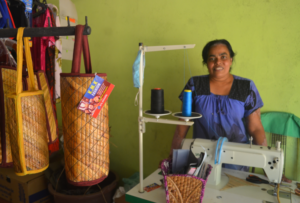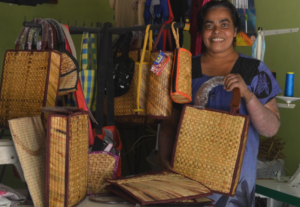Converting an Environmental Problem to Opportunity: The Eco-Friendly Utilization of Water Hyacinth in a Tank Ecosystem
By Ganga Kariyawasam, Ishan Erandika & Sakshi Selvanathan (06th October 2021)
If we aim to start a manufacturing business, we have to spare a large portion of the capital for raw materials. Interestingly, the raw material of Udeni Dhammika’s handicraft business is an aquatic weed known locally as ‘Japan Jabara’, and is one that is freely available in her village. Nevertheless, it had become a disturbance to her village’s tank[1] ecosystem.
Water hyacinth or ‘Japan Jabara’ (Eichhornia crassipes) is a free-floating and flowering invasive aquatic plant present in many tank ecosystems in Sri Lanka. It originated from the Amazon Basin in South America and was introduced to Sri Lanka as an ornamental plant in 1905. Eventually, however, it became a common invasive plant in most water bodies. It typically spreads very quickly, mainly by runners (stolons), which produce new plants and doubles itself within 5–15 days, and by producing seeds through flowers.
Water hyacinth has many negative environmental, social and economic impacts. The key environmental impacts include: increased water loss in water bodies due to evapotranspiration, decline in the diversity and abundance of aquatic life, decline in water quality, and increased siltation. The lack of clean water, limited access to water points for domestic and livestock use, and the disappearance of the aesthetic value of water bodies are the main social impacts. And water loss in tanks due to evapotranspiration, reduced fish catches and interference with irrigation (blockage of canals) are the leading economic impacts, which have direct effect on agriculture.
Despite the host of negative impacts, water hyacinth is capable of assimilating large quantities of trace elements and heavy metals (bioaccumulation[2]), and is thus considered to be a biological remediating agent for hazardous pollutants. It is effectively used for the treatment of contaminated water since it has wide acceptance in phytoremediation[3], therefore the removal of impurities in tank water could be effectively done using Water Hyacinth. Accordingly, use of these plants to make handicrafts is the best remedial therapy for cleansing trace elements and heavy metals from the environment.
“Most of the tanks in our area are covered with Japan Jabara plants,” says Udeni, showing her handicrafts, “We collect these plants, separate the stalks and sundry, then use dry stalks as raw material to produce various handicraft items such as handbags, pouches, baskets, mats, file covers and hats”.
Udeni Dhammika (46), lives in Madadenigama village in Ehetuwewa Divisional Secretariat area in the Kurunegala district in Sri Lanka, and she is an entrepreneur with sewing and knitting skills. She used to produce garments for her community until she attended a training in 2018, which signified the turning point of her business venture.
“The Divisional Secretariat Office of Ehetuwewa trained us to make handcrafts using Japan Jabara and then formed a manufacturer group. The Samurdhi bank, which is a government rural bank in Ehetuwewa, was planning to develop the market for our handicrafts in Galgamuwa area in the Kurunegala district. I am the team leader of my group and we are a five-member group. Currently we produce handicrafts to cater orders we get from schools, government offices and private companies”, Udeni says with a cheerful smile. Currently there is a trend towards manufacturing eco-friendly products, thus the country is going for an eco-products-based market and government is encouraging such manufacturers.
Udeni recalled her past: “Those days my problem was to finish orders on time due to lack of proper equipment. We used traditional methods; manual de-watering and pressing of the stalks. I also had only an old sewing machine. So it was not easy and very time consuming”.
When the situation was such, she received a new sewing machine and a de-watering machine from the Climate Resilient Integrated Water Management Project (CRIWMP) or “Wew Gam Pubuduwa” Project in 2020, which sped up Udeni’s handicraft production. “Now I am happy since I can supply orders on time, and doing so helped me to get more orders and ultimately increased my income too,” she further added. She is a successful entrepreneur, who combines her creativity with her skills, produces beautiful handicraft items and makes a successful living out of them.
The objective of the project was to promote manufacturing of handicraft using the water hyacinth and simultaneously control the expansion rate of water hyacinth in the Anguruwella cascade system. This is due to the fact that the expansion rate of water hyacinth is too severe at present, and is an issue which requires the coordination of all stakeholders to control it. The science of water hyacinth management is known but the knowledge of how to apply the integrated water hyacinth control approaches is challenging. But it is a mission which the Sri Lanka Red Cross Society seeks to complete.
About the CRIWMP or Wew Gam Pubuduwa:
The Sri Lanka Red Cross Society mobilizes farmer communities in the dry zone to adapt climate resilient agricultural activities. The CRIWMP is a 7-year project started in 2017, aimed at strengthening the resilience of Smallholder Farmers in Sri Lanka’s Dry Zone to unpredictable climate variability and extreme events.
The Project is financed through a grant received from Green Climate Fund (GCF) while the Government of Sri Lanka has committed to co-finance the activities identified under the Project as well. Ministry of Irrigation, is an implementing partner for this project, with technical assistance of the United Nations Development Program (UNDP) and work with a number of government institutions to deliver the project activities and outputs while measuring its’ impact.
[1] Tank (locally called as “Wewa”) is a man-made reservoir for retaining water mainly for irrigation, and is a part of ancient irrigation system in Sri Lanka.
[2] The gradual accumulation of substances, such as pesticides or other chemicals, in an organism.
[3] Use of plants and their associated microorganisms to clean up soil, air and water contaminated with hazardous contaminants.
